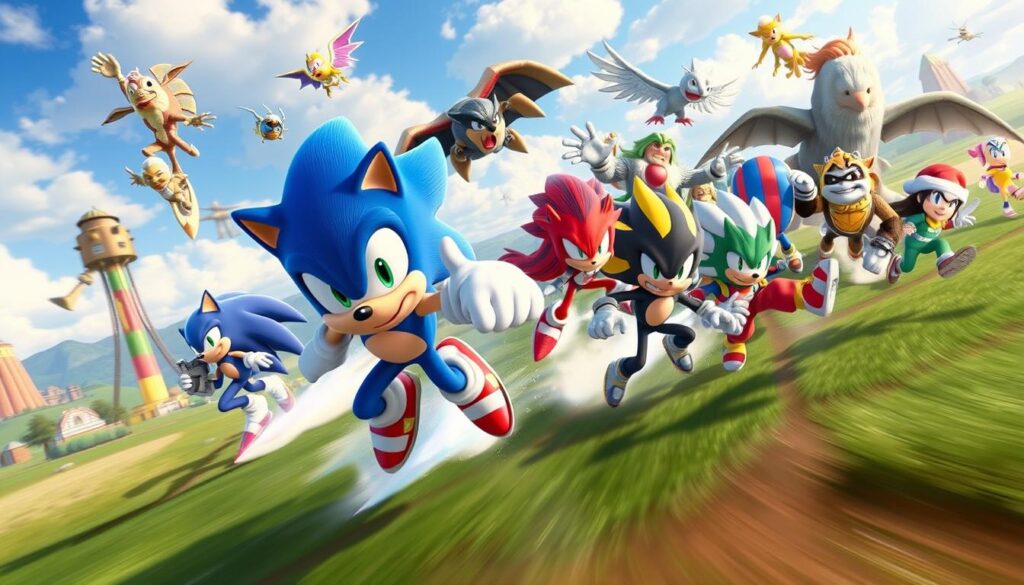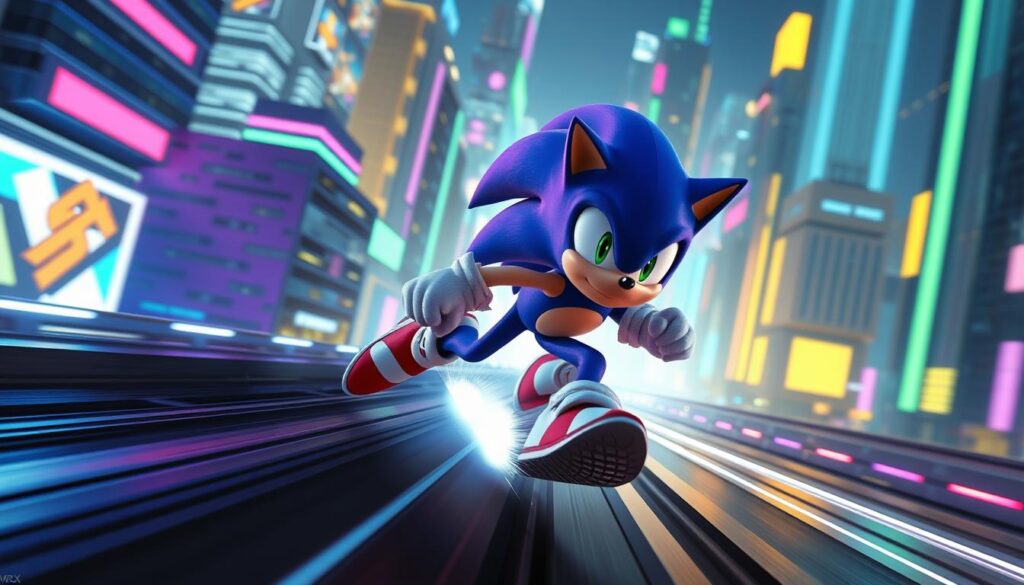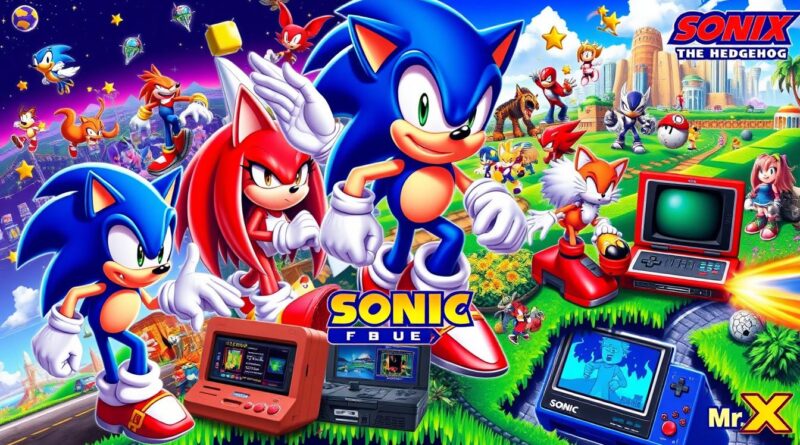The Complete History of Sonic The Hedgehog
Every generation has its heroes. For many of us who grew up in the ’90s, Sonic the Hedgehog was our speed and adventure icon. Remember the first time you held that controller? Your heart was racing as you sped through colorful worlds with Sonic.
Sonic’s charm quickly became a big part of our lives. He wasn’t just a game; he was a moment that brought friends together and sparked passions worldwide. This article takes you on a journey through Sonic’s history, starting in 1991. It shows how Sega’s flagship series became a key part of video game culture.
From his debut to his evolution, Sonic has inspired many adventures and memories. Join us as we explore this exciting story. We’ll highlight key moments and developments that show why Sonic is so beloved.
Key Takeaways
- Sonic the Hedgehog debuted in 1991, marking the beginning of a legendary gaming franchise.
- The character represents Sega’s flagship series, captivating gamers worldwide.
- Sonic’s design and gameplay mechanics introduced a new era of fast-paced platforming.
- Over the years, Sonic evolved with technology and trends in gaming.
- The blue blur continues to influence pop culture with merchandise, shows, and collaborations.
The Birth of a Blue Blur
The introduction of a hedgehog protagonist changed the gaming world. Sega wanted to stand out against Nintendo’s Mario. The creative vision behind Sonic’s design was crucial in making him stand out.
With a focus on speed and attitude, Sonic became more than a game character. He became a symbol for Sega.
The Concept Behind Sonic
The idea of Sonic was to create a character that was different from others. The team aimed for coolness and a bit of aggression, appealing to adults. Naoto Ohshima, the lead designer, saw Sonic as a lively, optimistic rebel.
This personality resonated with players, making Sonic a beloved figure in gaming.
Designing Sonic’s Iconic Look
Sonic’s look was both strategic and creative. He was inspired by a hedgehog and had sneakers. His blue color was chosen to match Sega’s brand.
This design made Sonic recognizable beyond his games. His unique look and personality have made him a lasting icon.
Sonic’s Debut: The First Game
When Sonic the Hedgehog first came out on the Sega Genesis in 1991, it was a big deal. It changed the game for platforming games, offering fast action and cool designs. The Green Hill Zone, with its bright colors and lively scenes, really caught people’s attention.
Launching on the Sega Genesis
The Sega Genesis made Sonic stand out. Its strong hardware meant smooth graphics and quick gameplay. Players loved the challenges each level brought, showing off the console’s power.
Features That Made it a Hit
Sonic’s first game had cool features. Rings added a fun twist, and emeralds added strategy. These, along with fast action and great level designs, made it a hit. Sonic games were unlike anything else at the time.
The Legacy of Level Design
The levels in Sonic’s first game set a high standard for platformers. Each stage, like the Green Hill Zone, showed off creativity and detail. This made Sonic a legend and influenced many games, leaving a mark on gaming history.
Expanding the Sonic Universe
Sonic the Hedgehog has grown a lot since it started. It now has a colorful cast of characters that make the games more exciting. Tails, Knuckles, and Dr. Robotnik have all added their own special touches to the stories.
Introduction of Key Characters
The Sonic franchise has welcomed many iconic characters. Tails brings friendship and support to Sonic’s adventures. Knuckles adds strength and rivalry, making the games more engaging.
These characters make the gameplay better and the stories richer.
The Role of Dr. Robotnik
Dr. Robotnik, or Eggman, is the main villain. He wants to control the Chaos Emeralds, causing trouble for Sonic. His plans create tension and excitement for players.
Dr. Robotnik shows the dangers of ambition, adding depth to the series.
Friends and Foes: The Ensemble
The Sonic series has a diverse cast of friends and foes. Amy Rose, Shadow, and Rouge the Bat add different stories and motives. Their relationships make the games more interesting and reflect themes like loyalty and friendship.
| Character | Role | Notable Traits |
|---|---|---|
| Sonic | Hero | Speed, Bravery |
| Tails | Sidekick | Intelligence, Flight |
| Knuckles | Rival | Strength, Determined |
| Dr. Robotnik | Antagonist | Genius, Cunning |
Sonic’s Rise in Popularity
The 1990s saw a huge leap in Sonic the Hedgehog’s popularity. A big reason was the wide range of sonic merchandise. This included toys, clothes, and collectibles. It made Sonic a name everyone knew, across many generations.
The Influence of Merchandise
Sonic merchandise was key in shaping the franchise’s image. From action figures to clothes, it all helped define Sonic. The marketing used game characters and elements, making fans feel closer to the franchise. Sonic’s reach went beyond games, touching many parts of popular culture.
Sonic as a Cultural Icon
As merchandise grew, Sonic became a cultural icon. He stood for speed and youth, appealing to many. Events and conventions celebrated Sonic, showing a strong fan community. His games and merchandise greatly influenced his cultural impact.
The Impact of Animated Series
The animated series, like “Adventures of Sonic the Hedgehog,” made Sonic more visible. These shows drew in young viewers, introducing Sonic to new fans. They mixed exciting stories with Sonic’s adventures, growing his fanbase. This mix showed Sonic’s appeal in many ways.
Transition to 3D Gaming
The world of gaming changed a lot with 3D gaming. It brought new chances and challenges for old favorites. Sonic Adventure on the Sega Dreamcast in 1998 was a big step. It showed Sonic in a new 3D world, giving fans a big place to explore.
Sonic Adventure’s Introduction
Sonic Adventure brought a new level of fun and stories to games. It had big worlds and many characters to play as. This made the game exciting as players collected rings and fought enemies in a beautiful 3D setting.
Innovations in Gameplay
Sonic Adventure changed how we play games. It had:
- Multiple characters with special powers
- Exploration that added to the fun
- Control over the camera for better views
- Levels that were tough and used 3D movement
These changes made the game feel more real and connected to Sonic’s world.
Reception and Critiques
Even though it was new and exciting, Sonic Adventure got mixed reviews. Some loved the fun gameplay and creative levels. But others found the 3D parts hard to get used to. This sparked a big debate about what Sonic games should be like in the future.
Sonic’s Continued Evolution
Sonic the Hedgehog has changed a lot since 2000. He keeps up with new tech and gaming trends. His journey shows how the franchise has innovated and tried new things, based on what players want.
Rendering in New Technologies
With better graphics, Sonic became more visually stunning. Games like “Sonic Generations” used new tech to make him look amazing. These updates made the games look better and feel more real.
Experimentation in Game Design
The Sonic series has always been open to new ideas. “Sonic Unleashed” mixed fast action with slow exploration. This mix gave players a new way to enjoy the game and explore its world.
Notable Releases Post-2000
After 2000, Sonic had some big hits. “Sonic Heroes” focused on teamwork, letting players play together. “Sonic Colors” brought in new platforming and bright colors, changing how Sonic games were made.
The Sonic Boom Franchise
The sonic boom franchise is a big step forward in the Sonic universe. It shows off Sonic and other spin-offs, aiming to win over new fans and keep old ones. The series started to use more fun stories and a lighter feel, making it fun for more people.
The Spin-Off Series
The spin-offs brought new gameplay and favorite characters in new places. Games like *Sonic Boom: Rise of Lyric* and *Sonic Boom: Shattered Crystal* were all about fun and keeping Sonic’s charm. Players could switch between characters, using their special skills.
The 2014 Cartoon
In 2014, the cartoon series changed how Sonic and friends were seen. It was funny and showed their adventures and interactions. It was fun for kids and brought back memories for adults, making Sonic more appealing.
Reception and Merchandise
People had mixed feelings about the sonic boom franchise. Some said the games had problems but loved the cartoon’s character growth. The merchandising, like clothes and toys, also caught fans’ attention. It made Sonic a big part of pop culture.
Collaborations and Crossovers
Sonic the Hedgehog has made a big impact in his own games and others. He has starred in exciting crossover games. These games mix characters and gameplay from different worlds.
These collaborations have brought fans together. They show how Sonic is a key part of the gaming world.
Sonic in Other Game Universes
Sonic is a big hit in the “Super Smash Bros.” series. He battles with famous characters from other games. His speed and agility shine in these battles.
This mix of heroes and villains makes the game more fun. It appeals to fans of many different games.
Mentions in Popular Media
Sonic has also made waves in pop culture. He has been in TV shows and movies. This has made him a favorite among many.
Every time Sonic appears, he reaches new fans. This keeps him fresh in the ever-changing world of entertainment.
Collaborative Events with Other Brands
Sonic has teamed up with brands for special events. These partnerships offer fans unique ways to enjoy Sonic. From clothes to in-game deals, they keep Sonic in the spotlight.
These efforts celebrate Sonic’s legacy. They show his impact across different cultures.

Fan Culture and Sonic
The sonic fandom has grown into a vibrant tapestry of creativity and collaboration. It brings together fans from all walks of life. Online communities have formed, providing spaces for passionate individuals to share their love for the franchise.
This unity fosters not only friendships but also encourages unique expressions through various art forms.
The Rise of Fandom Communities
As the sonic fandom flourished, dedicated communities emerged across platforms like Reddit, Discord, and Tumblr. Fans connect over shared interests, discussing game strategies, character lore, and upcoming releases. These platforms serve as hubs for collaboration.
They enable fans to organize events and celebrate their mutual admiration for the blue hedgehog.
Fan Art, Music, and Fan Games
One of the most thrilling aspects of the sonic fandom is the outpouring of creativity. Fans create stunning illustrations that pay homage to beloved characters. Musicians compose original soundtracks inspired by the games, bringing new life to classic themes.
Further, talented developers craft fan games that expand on the sonic universe. They showcase how deeply fans engage with the source material.
The Impact of Sonic Generations
Sonic Generations holds a special place in the hearts of fans. It celebrates the franchise by blending iconic levels from both classic and modern games. This title not only highlighted the evolution of gameplay but also resonated with fans who appreciated its nods to nostalgia.
The game encouraged community members to reflect on their experiences and share their excitement. It reinforced the bonds within the sonic fandom.
Sonic’s Historical Milestones
Sonic the Hedgehog has left a lasting mark on gaming history. Fans celebrate key anniversaries, looking back at Sonic’s journey. Events and game launches remind us of Sonic’s impact on gaming.
Key Anniversaries Celebrated
Anniversaries like the 25th and 30th have brought fans together. They celebrate Sonic’s history with unique activities and promotions. These events excite both old and new fans, welcoming them to Sonic’s world.
Major Game Releases Through the Years
Iconic games like “Sonic The Hedgehog” and “Sonic Adventure” have shaped Sonic’s legacy. These games have set high standards for platformers. They show Sonic’s innovation and creativity, loved by fans worldwide.
Retrospectives and Remembrances
As anniversaries near, fans look back at Sonic’s milestones. They share favorite moments and celebrate Sonic’s influence on gaming. Special events highlight Sonic’s role in entertainment, enriching the community’s experience.
| Year | Anniversary | Major Game Release | Event Highlights |
|---|---|---|---|
| 2016 | 25th | Sonic Boom: Fire & Ice | Special events and merchandise launches |
| 2021 | 30th | Sonic Colors: Ultimate | Anniversary celebration video and new game announcements |
| 2023 | 31st | Upcoming Releases | Retrospective events in gaming conventions |
Sonic in Competitions
Sonic the Hedgehog has found a special place in gaming competitions. Sonic esports has become a big part of this, where players compete in timed challenges. These events celebrate Sonic’s fast-paced games and build a strong gaming community.
Esports and Sonic Challenges
Competitive gaming loves Sonic’s exciting gameplay. Tournaments, known as sonic esports events, bring players from all over. These challenges let players show off their skills and get recognized by gamers everywhere.
Speedrunning Communities
Speedrunning is a big part of Sonic fandom. Players try to beat game records by racing against the clock. Online events let fans share tips and celebrate their wins. The speedrunning community is all about friendly competition and love for Sonic.
Competitions and Fan Events
Fan competitions show how much Sonic is loved. Community events bring players together for different challenges. These events are full of excitement, bringing fans closer through their love for Sonic.
| Event Type | Description | Community Involvement |
|---|---|---|
| Sonic Esports Tournaments | Competitive events featuring various Sonic games | High participant engagement |
| Speedrunning Events | Races to complete games in the shortest time | Active sharing of techniques and strategies |
| Fan-hosted Competitions | Community-driven contests celebrating Sonic | Strong sense of belonging among fans |
Future of Sonic the Hedgehog
The future of Sonic the Hedgehog is bright. The franchise is growing, with many new games coming. These games will mix old-school fun with new twists, appealing to all fans.
Upcoming Game Releases
New games are on the way, promising to bring Sonic back to life. Each game will have its own special features, showing how Sonic can stay fresh. Fans are excited to see how these games will take Sonic to new levels.
Trends in Game Development
Game development is moving towards open worlds and playing on different platforms. Sonic might offer players never-before-seen experiences. Better graphics and stories will let Sonic explore new themes and stories.
New Directions for the Franchise
Sega is planning big changes for Sonic. They might add multiplayer and interactive stories. These changes will meet what players want and what’s popular, keeping Sonic exciting for everyone.

| Upcoming Game Titles | Release Date | Key Features |
|---|---|---|
| Sonic Frontiers | November 2022 | Open-world exploration, new mechanics |
| Sonic Rangers | 2023 | Multiplayer options, rich storytelling |
| Sonic Adventure Remake | Expected 2024 | Enhanced graphics, revamped gameplay |
Conclusion: Sonic’s Legacy
Sonic the Hedgehog has been a favorite for over 30 years. He’s known for his speed and charm. This character is more than just a game; he’s a symbol of joy and a key part of gaming history.
With every new game, Sonic shows us the power of innovation and nostalgia. He connects with players all over the world.
Reflection on Over Three Decades
Sonic’s journey in gaming is a long and exciting one. His legacy is filled with achievements and milestones. These have made him a beloved character across different generations.
Sonic’s Impact on Video Gaming
Sonic has had a huge impact on video games. He changed the platformer genre in the 1990s and inspired many others. His unique style and energy continue to influence today’s games.
The Enduring Joy of Sonic
Sonic’s spirit of adventure has kept players coming back for more. The thrill of racing, the music, and the friendships all add to the joy. Sonic has evolved but kept his core traits, making him a cherished icon.
| Aspect | Details |
|---|---|
| Years of Existence | Over 30 years |
| Key Contributions | Revitalized platforming genre, Cultural icon, Influencer of game design |
| Character Traits | Speed, Bravery, Charisma |
| Legacy Impact | Inspiration for new games, Fostering a sense of community |
References and Further Reading
The journey of Sonic the Hedgehog has been well-documented. For those wanting to learn more, there’s a lot of sonic literature out there. This includes books and articles that cover important moments, game development, and interviews with the creators.
These resources give a full picture of Sonic’s growth and why he’s loved in gaming culture.
Books, Articles, and Interviews
Many publications focus on Sonic, looking at everything from gameplay to character design. Interviews with key developers share interesting stories and design ideas. Together, these sonic references entertain and teach fans about Sonic’s world.
Official Sonic the Hedgehog Websites
Official Sonic websites have the latest news and updates. They offer exclusive content, promotional materials, and a timeline of Sonic’s history. These sites keep fans up-to-date and involved with Sonic’s journey.
Community Resources and Forums
Community resources and forums are great for Sonic fans. They’re places for discussions, creativity, and sharing Sonic experiences. By joining these forums, fans can find valuable information, work on projects, and make friends who love Sonic as much as they do.
FAQ
What year did Sonic the Hedgehog first debut?
Sonic the Hedgehog first appeared in 1991 on the Sega Genesis. He quickly became Sega’s top series. His speed and charm won over many players.
Who designed Sonic the Hedgehog?
Naoto Ohshima designed Sonic. He wanted a hedgehog that was fast and had attitude. This made Sonic a beloved gaming icon.
What are some of the key features of the original Sonic game?
The first Sonic game, set in the Green Hill Zone, was all about speed. Players collected rings and searched for Chaos Emeralds. This formula set the stage for future Sonic games.
What role does Dr. Robotnik play in the Sonic series?
Dr. Robotnik, or Eggman, is Sonic’s archenemy. He tries to use the Chaos Emeralds to take over the world. Sonic always stops him.
How has Sonic’s popularity impacted merchandise and cultural representation?
Sonic’s fame in the 1990s led to lots of merchandise. This made him a cultural icon in gaming and beyond. He’s been in animated shows and many products.
What advancements have been made in Sonic games in relation to 3D gaming?
Sonic moved to 3D with “Sonic Adventure” in 1998. This game introduced new gameplay and characters. But, it got mixed reviews.
Can you describe the Sonic Boom franchise?
The Sonic Boom franchise includes games and a 2014 animated series. It has a funny tone. While it’s expanded Sonic’s appeal, it’s also gotten mixed feedback.
How has Sonic been featured in crossovers with other games?
Sonic has appeared in games like “Super Smash Bros.” This has made him even more famous in pop culture.
What role do fandom and community play in Sonic’s ongoing legacy?
Sonic fans create art, music, and games. They keep the Sonic spirit alive with their creativity and enthusiasm.
What upcoming trends can we expect in future Sonic games?
Future Sonic games might include open-world formats and cross-platform play. These trends could bring exciting changes to the franchise.




